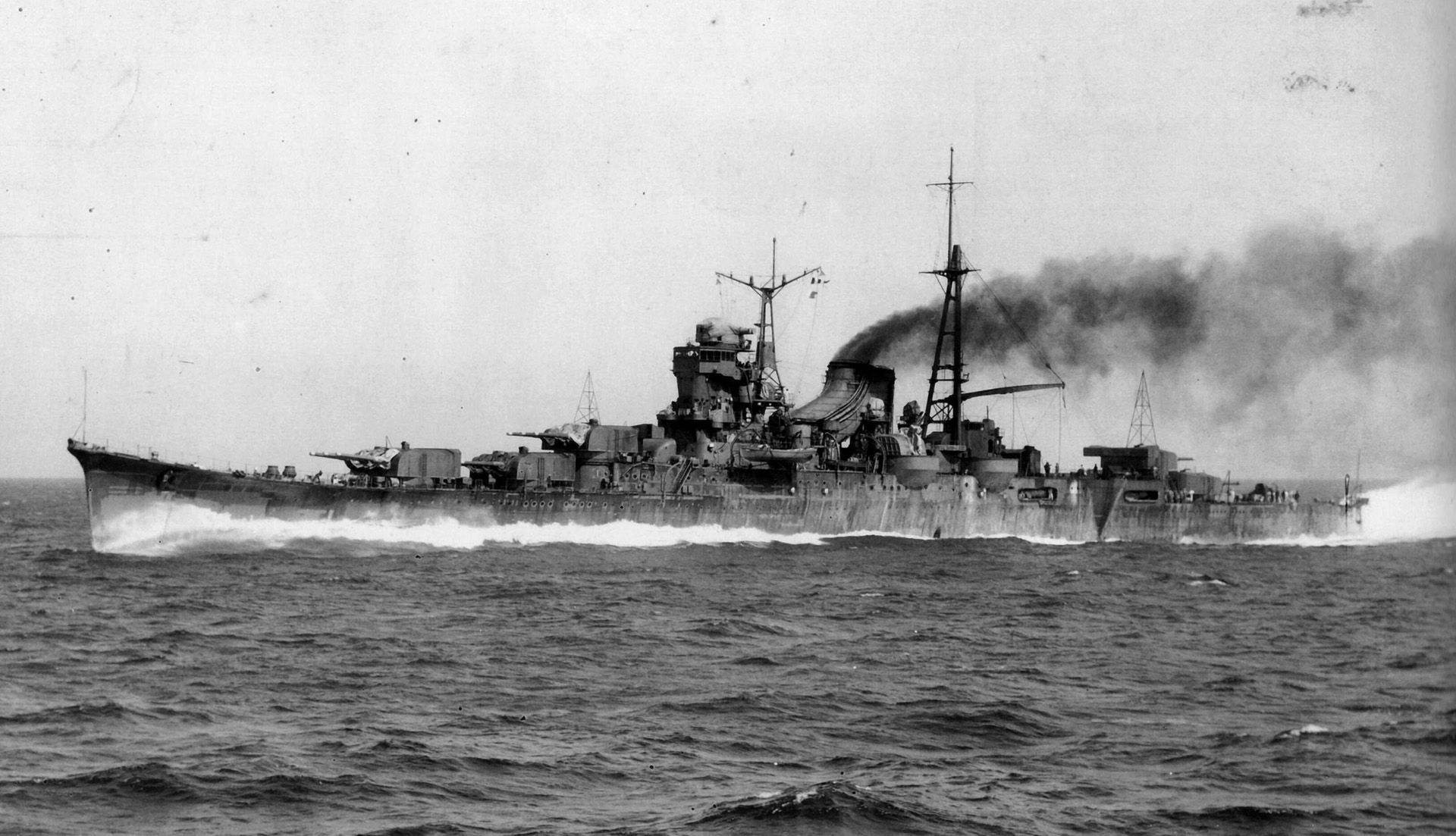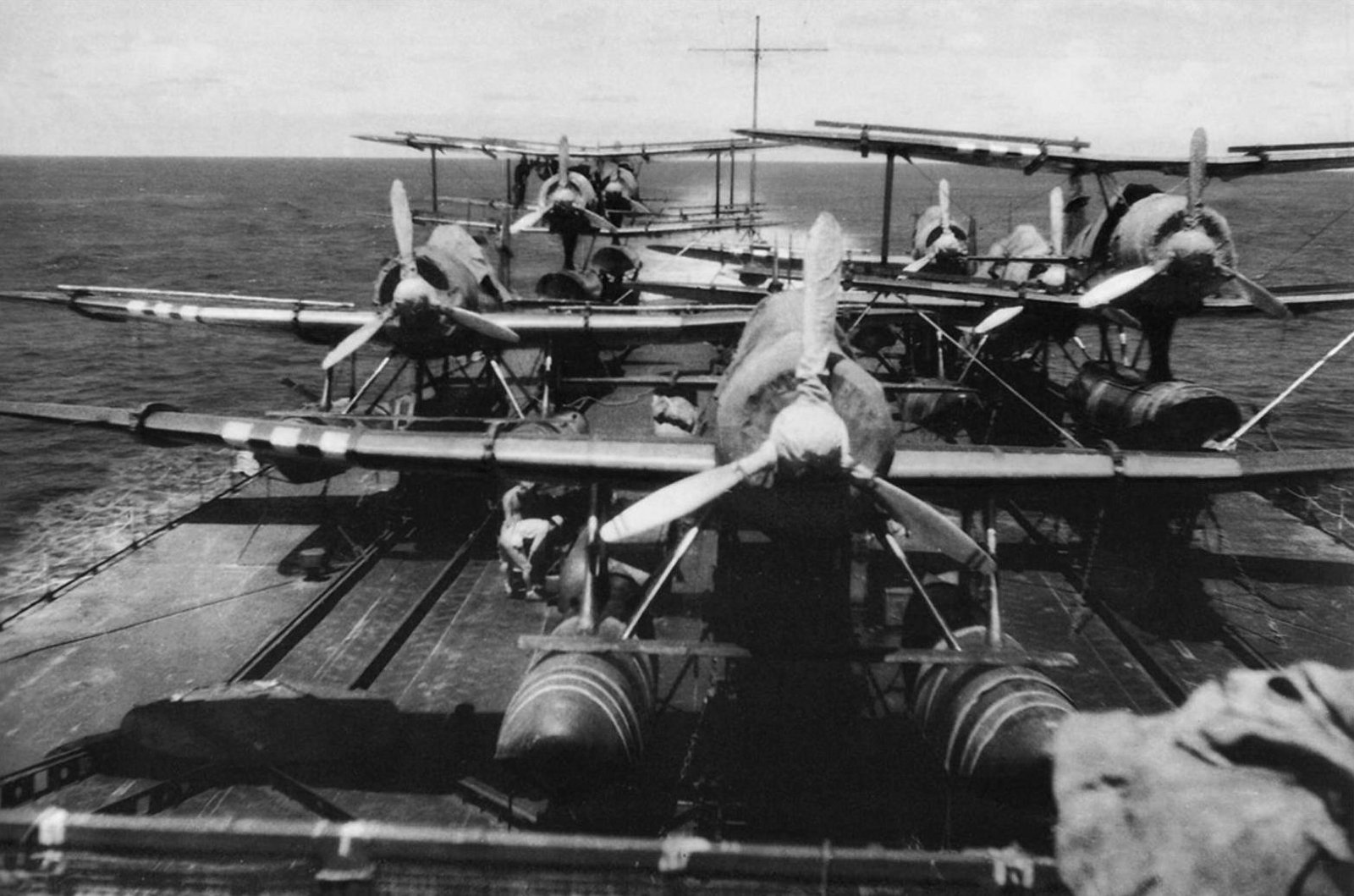| Japan’s Unlucky Ship
The Cruiser Mogami
By Mike Bennighof, Ph.D.
February 2025
 In 1930 Japan signed the London Naval Treaty,
imposing limits on cruiser, destroyer and
submarine tonnage at the same 10:10:7 ratio
to which the United States, Britain and Japan
had agreed in 1922 for battleships. Cruisers
armed with 8-inch guns and those with 6-inch
guns fell into separate categories, and so
all three navies planned new classes of light
cruisers armed with 6-inch guns. Size limits
remained the same as for 8-inch cruisers,
and so these new “light” cruisers
would be as large as their “heavy”
counterparts. In 1930 Japan signed the London Naval Treaty,
imposing limits on cruiser, destroyer and
submarine tonnage at the same 10:10:7 ratio
to which the United States, Britain and Japan
had agreed in 1922 for battleships. Cruisers
armed with 8-inch guns and those with 6-inch
guns fell into separate categories, and so
all three navies planned new classes of light
cruisers armed with 6-inch guns. Size limits
remained the same as for 8-inch cruisers,
and so these new “light” cruisers
would be as large as their “heavy”
counterparts.
The United States built its Brooklyn class with fifteen 6-inch guns in five
triple turrets, and Japan planned its own Mogami class with a similar armament.
Both navies also intended to replace the turrets
with new ones each carrying two 8-inch guns
at some future date, but in the United States
this remained only a paper exercise. Japan
went much further.
Mogami, the lead ship of the class
of four, was laid down in late 1931 as an
8,500-ton light cruiser with fifteen 6-inch
guns and a designed speed of 37 knots. To
meet the nearly insane targets for speed and
armament on such a small displacement, Japanese
designers employed extensive electric welding
techniques, and gave her very little armor
protection.

Mogami on trials, 1935. Note the triple 6-inch turrets.
The Mogami class had a good reputation
among Japanese sailors and became prime assignments
thanks to much better living quarters than
other cruisers. Unlike most other Japanese
ships, they were air-conditioned, had steel-tube bunks in place of hammocks, cold water
drinking fountains dispersed throughout the
ship, and more extensive refrigeration space
than other cruisers (meaning the crew ate
much better chow). And like all Japanese ships,
they had several pickle lockers in different
parts of the ship, for careful study had found
that a crew that ate pickles daily was more
efficient than one that did not. However,
the air conditioning system proved to be very
noisy, and was not installed in subsequent
ship classes.
Mogami’s bow collapsed during
her first deployment in late 1935 thanks to
poor welding, and the crew found the hull
had warped so badly that they could not train
her turrets. An investigation board ordered
her disarmed and drydocked for extensive reconstruction.
She received new riveted steel plates amidships
along her sides as well as a new double bottom
along the keel. Mogami and her sisters
also received new bulges, increasing her displacement
to over 10,000 tons and dropping her speed
by several knots. Her twelve 21-inch torpedo
tubes gave way to a dozen 24-inch 93 Shiki
(“Long Lance”) tubes, though reloads
dropped from 12 to six.
She emerged in February 1938 as a much more
efficient warship. But even while she still
lay in drydock, new 8-inch turrets had been
ordered for the class. She was not fully commissioned
before being sent back into the Kure dockyard
in December for re-armament with 8-inch main
guns, finally re-joining the fleet in April
1940.
While the cruiser Chokai had been
tagged as the Imperial Navy’s lucky
ship, Mogami had a reputation for
ill fortune. She suffered typhoon damage during
her first deployment in September 1935. When
war broke out, she helped cover landings in
Malaya and Borneo, and then moved on with
her squadron to the operations in the Java
Sea as shown in Java Sea.
On 27 February 1942, Mogami and Mikuma were covering landings in
Banten Bay on Java. On the next evening, they
were attacked by the combined Allied cruiser
force. The two cruisers sank the American
heavy cruiser Houston and the Australian
light cruiser Perth, but during the
course of the action Mogami confirmed
her status for all Imperial Navy sailors.
She fired a spread of six “Long Lance”
torpedoes that proved to be one of the most
devastating of the entire war: they sank the
Japanese Army landing ship Ryujo Maru, the Army transports Sakura Maru,
Tatsuno Maru and Horai Maru, and
the Navy minesweeper W-2.
After a refit in Japan, Mogami’s squadron was assigned to the Midway operation
as close support for the invasion force. At
midnight on 5 June, the squadron was ordered
to carry out a nighttime bombardment of Midway
Island the next evening; the cruisers were
about 90 miles from the island when sanity
prevailed and the bombardment was cancelled.
But at 2318 that night a lookout on the squadron
flagship Kumano spotted a surfaced
submarine, and the flagship ordered an emergency
turn. During the turn, Mogami rammed
her sister Mikuma on the port side
below her bridge, leaving a huge gash in Mikuma’s oil tanks. A massive oil slick spread
behind her.
Mogami’s bow crumpled, bending
back almost at a right angle all the way to
her forward 8-inch turret. Her speed dropped
to 12 knots. Kumano and Suzuya headed off, while the two stricken cruisers
and two destroyers made the best speed they
could, rising to 14 knots four hours later.
The planes came at dawn.
Twenty-six dive bombers struck at 0645, hitting Mogami twice. Fifty-four appeared
at 0930, hitting Mogami twice more
but concentrating on her sister. Mikuma took at least five hits; one started
a fire in her torpedo room and the Long Lances
exploded. With the captain gravely wounded,
the first officer ordered the crew over the
side. The ship sank later that day.
Two dozen more bombers attacked at 1145,
hitting Mogami on her aircraft deck
and sealing the hatches to her engine room,
killing the entire “black gang”
trapped below. Mogami survived with
90 killed and 101 wounded, limping back to
Truk and — after five weeks of temporary
repair there to make her seaworthy —
to Sasebo Navy Yard.
Mogami stayed at Sasebo from August
1942 until April 1943. She was rebuilt as
an aircraft cruiser, with her two aft turrets
(one of which had been destroyed at Midway)
removed and her aircraft deck extended all
the way to the stern. She also received a
greatly increased anti-aircraft armament,
and air search radar. In her new guise, she
had a capacity of 11 seaplanes. The old armored
barbettes under the turret rings became bomb-stowage
areas and gasoline tanks for the seaplanes,
and her fuel stowage was also increased.

A variety of seaplanes crowd Mogami's aircraft-handling deck, 1943.
Re-commissioned in May 1943, Mogami trained
for three weeks before receiving orders to
join the fleet preparing to sail for the Aleutian
Islands in response to the American landing
on Attu. While in Tokyo Bay preparing for
this mission, her bad luck returned when she
rammed the oiler Toa Maru.
The Aleutians operation never took place,
and Mogami transported Army troops
to Rabaul in July. She remained at Truk with
the Combined Fleet until early November, when
she was ordered to Bougainville to attack
American ships there. Staging to Rabaul, she
was attacked there by a single dive-bomber
from the American carrier Saratoga, which
hit Mogami between the first two turrets.
A severe fire broke out and the crew had to
flood both magazines, submerging the cruiser’s
bow.
Mogami went back to Truk for emergency repairs,
which lasted over a month. From late December
1943 until 17 February 1944 she was under
repair at Kure Navy Yard.
The aircraft cruiser participated in the “Sea
Battle off the Marianas” (Battle of
the Philippine Sea) without suffering damage,
but without contributing much to the Japanese
cause, either. Thanks to material shortages,
she only carried five seaplanes. When she
set sail for her last engagement, she had
eight planes aboard.
Mogami was part of Adm. Shoji Nishimura’s
Force C that attempted to penetrate the Surigao
Strait on 25 October 1944 and attack the American
beachheads in Leyte Gulf. At 0350 she was
hit by two 8-inch shells, and responded by
firing a spread of torpedoes and turning about.
As she turned, another shell struck her bridge,
killing Capt. Ryo Toma and most of his senior
officers. With the gunnery officer in charge
and her rudders moved manually, she attempted
to escape at high speed.
Once again, the cruiser’s bad luck
re-surfaced and at 0430 she plowed into the
heavy cruiser Nachi. The crew still
had not managed to put out the fire started
by the first shell hit, and a few minutes
after the collision it spread to the ready-use
ammunition piled alongside the midships anti-aircraft
batteries. As the shells cooked off, the torpedomen
began jettisoning their weapons lest they
explode as well. Bad luck was still with them:
At least one torpedo broke loose and rolled
into the flames, and in all five warheads
exploded. Mogami suffered massive
structural damage; the entire crews of two
of her four engine rooms perished immediately
while that of another had to evacuate due
to the extreme heat.
At 0530 three American cruisers (Louisville,
Portland and Denver) made contact
and hit Mogami between 10 and 20
times, but these did surprisingly little additional
damage. Mogami rejoined Nishimura’s
force, and the destroyer Akebono was
detailed to shepherd her home. But at 0830
her last engine broke down and 30 minutes
later American planes found the wounded cruiser.
They hit her with two bombs, and new fires
broke out in the forward parts of the ship.
Damage control parties kept the ship afloat,
but when they tried to flood the 8-inch magazines,
they found the valves too badly damaged. Fearing
a magazine explosion, Mogami’s gunnery officer ordered her abandoned. Akebono took off her crew, and sank the wreck
at 1240 with a single torpedo.

Author’s Note: If you’ve read something similar elsewhere . . . I wrote it first. And that’s all I have to say about that.
You can order Midway Deluxe right here.
Sign up for our newsletter right here. Your info will never be sold or transferred; we'll just use it to update you on new games and new offers.
Mike Bennighof is president of Avalanche Press and holds a doctorate in history from Emory University. A Fulbright Scholar and NASA Journalist in Space finalist, he has published a great many books, games and articles on historical subjects; people are saying that some of them are actually good.
He lives in Birmingham, Alabama with his wife and three children. He misses his lizard-hunting Iron Dog, Leopold.
Daily Content includes no AI-generated content or third-party ads. We work hard to keep it that way, and that’s a lot of work. You can help us keep things that way with your gift through this link right here.
|
